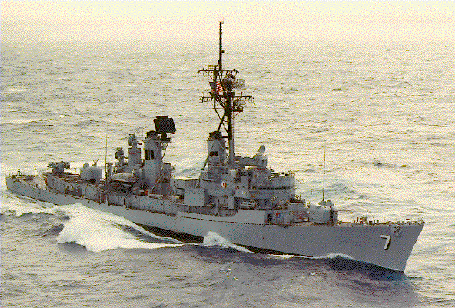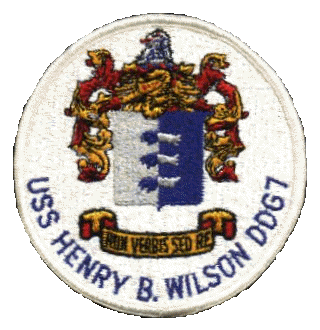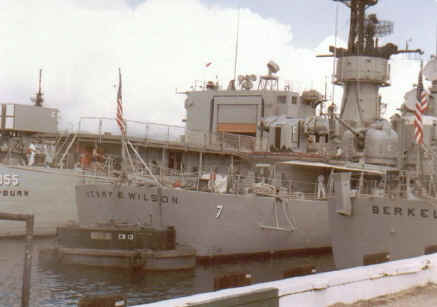|

A SHOT IN THE DARK
By Bob Cohen, Ensign, Boilers Officer
USS HENRY B. WILSON (DDG-7)
“On
the Henry B. Wilson, security alert, security alert!
Away the security alert team, away the back-up alert force!
All hands not involved, stand fast!”
 Anyone who served on a nuclear-capable destroyer will
remember hearing something like this over the ship’s 1MC, as well as the
familiar refrain, “I can neither confirm nor deny the presence of nuclear
weapons…” If you were a
member of the elite shipboard security force, you knew just what serious
business this was. If you
weren’t, all you knew was not to move during a security alert, if you knew
what was good for you. Anyone who served on a nuclear-capable destroyer will
remember hearing something like this over the ship’s 1MC, as well as the
familiar refrain, “I can neither confirm nor deny the presence of nuclear
weapons…” If you were a
member of the elite shipboard security force, you knew just what serious
business this was. If you
weren’t, all you knew was not to move during a security alert, if you knew
what was good for you.
A prerequisite to being assigned to
any security capacity was a thorough mastery of shipboard small-arms: .45
caliber M1911 pistol, 12-gauge M870 shotgun and the 7.62mm M14 rifle.
These three weapons were unsurpassed in their effectiveness, and with
them, we were confident in our ability to protect whatever nuclear devices we
had aboard. That is, if we had any.
Or if we didn’t. I still
can’t say.
One of the first rules in nuclear
security was this:
There is No Such Thing as a Drill.
All security alerts are the real deal, every single time.
There were many things which could trigger a security alert, none of
which can be described here.
There was only one thing which could end (‘secure’) a security alert,
and that was the Command Duty Officer saying something which I also can’t tell
you. Sorry.
Nuclear-capable warships didn’t
always carry nuclear weapons. Sometimes
you had them, sometimes you didn’t. Nobody
knew for sure except the Captain, the Weapons Officer and the Anti-Submarine
Officer. At sea, it made no
difference in the routine. Inport,
it made a big difference, and the rest of us could take an educated guess using
certain tell-tale indicators: Who
is getting liberty and who isn’t? Does
the ship always conveniently go to security alert right after supper?
Or is it a madhouse? While
I can’t give the answers to these questions here, I will say that sometimes a
ship’s status would mysteriously change after a visit to that top-secret pier
where they’d bring something aboard or take something away.
Whatever it was, it was covered by canvas, so I couldn’t say for sure
what it was. Or wasn’t.
But the heavily-armed Marines who escorted it looked very serious either
way.
sometimes you didn’t. Nobody
knew for sure except the Captain, the Weapons Officer and the Anti-Submarine
Officer. At sea, it made no
difference in the routine. Inport,
it made a big difference, and the rest of us could take an educated guess using
certain tell-tale indicators: Who
is getting liberty and who isn’t? Does
the ship always conveniently go to security alert right after supper?
Or is it a madhouse? While
I can’t give the answers to these questions here, I will say that sometimes a
ship’s status would mysteriously change after a visit to that top-secret pier
where they’d bring something aboard or take something away.
Whatever it was, it was covered by canvas, so I couldn’t say for sure
what it was. Or wasn’t.
But the heavily-armed Marines who escorted it looked very serious either
way.
The second rule in nuclear security was not to actually
load small-arms until a very specific time.
The normal procedure was to be issued your pistol, shotgun or rifle and
receive the ammunition separately, and you would keep them that way –
separate. This might have been to
further the plausibility of the statement, “I can neither confirm nor
deny…” but I really can’t say.
We were in-port San Diego, in that blissful
once-daily (right after supper) “no such thing as a drill” security mode
when another destroyer ties up alongside of us.
I can’t say whether or not they were carrying nuclear weapons, but I
will say that we couldn’t wait for them to leave.
Nothing personal here, it’s just that when one ship in a nest goes to
security alert, then all ships in the nest go to security alert.
It’s another rule.
So, now we’re a madhouse, too.
We’re going to security alert a dozen or more times a day, and
everything grinds to a halt each and every time. It’s really getting to be a pain in the neck,
especially since we all know damn well that we don’t know whether or not
we’re carrying nuclear weapons.
 I’m sound asleep one night when that stupid loudspeaker
starts blaring for the umpteenth time, “Security alert, security alert!”
I drag myself out of my rack and shuffle to the small-arms locker
where I line up silently with all the other sleepyheads who dutifully receive
their pistols and shotguns. Head down and still half-asleep, I go to where I’m supposed
to go, holding the shotgun by the muzzle. The
only sound is the butt dragging on the deck behind me.
I get to my position and I’m just trying to stay awake waiting for the
Command Duty Officer to come by and secure me, when
POW!!
A shot rings out! Throughout the Henry B. Wilson, you can hear magazines being
slammed in and slides being racked. Without
giving away any security procedures, specifically, this was exactly the time to
do that – but you didn’t get it from me. I’m sound asleep one night when that stupid loudspeaker
starts blaring for the umpteenth time, “Security alert, security alert!”
I drag myself out of my rack and shuffle to the small-arms locker
where I line up silently with all the other sleepyheads who dutifully receive
their pistols and shotguns. Head down and still half-asleep, I go to where I’m supposed
to go, holding the shotgun by the muzzle. The
only sound is the butt dragging on the deck behind me.
I get to my position and I’m just trying to stay awake waiting for the
Command Duty Officer to come by and secure me, when
POW!!
A shot rings out! Throughout the Henry B. Wilson, you can hear magazines being
slammed in and slides being racked. Without
giving away any security procedures, specifically, this was exactly the time to
do that – but you didn’t get it from me.
It took over an hour for our Command Duty Officer to
secure all the now wide-awake, heavily-armed crewmembers who had squirreled
themselves into positions of cover and concealment.
Many did not accept what the Command Duty Officer had to say when he
ordered them to secure from security alert; instead, they (although I can’t
say who) simply offered to shoot the Command Duty Officer if he
entered their field of fire. This
delay nearly caused one of the sailors from the other ship to bleed to death.
It turned out that when we went to alert status, the sailor in question did
something he wasn’t supposed to do - he inserted a
loaded magazine into his .45 caliber pistol, dropped the slide and promptly shot
himself in the foot.
He stood there the whole time, frozen, just staring at his foot
while it leaked all over the deck.
The explanation for his turning to stone was simple: what with all the
real security his little faux-pas set in motion, he was justifiably terrified
that if he moved an inch one of his shipmates was going to put some more
unwanted holes in him.
As far as why he decided to lock and load in the first place, well…
Don’t ask.

 

|
